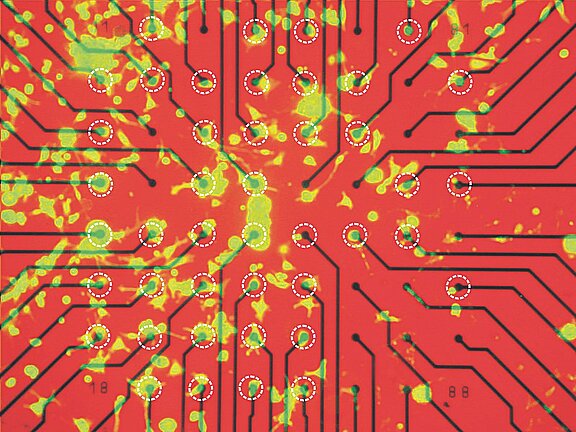
Development of Microelectrode Arrays

Next Generation Cellular and Organotypic Assays
Microelectrode Arrays (MEAs) are instrumental in electrophysiology, enabling the capture of electrical activity of networks of single in both in-vitro and in-vivo contexts. These arrays shed light on the behaviours and responses of cell cultures, organs, and organoids, whether observed over time or upon external stimulation. Select MEAs even possess the capability to target specific regions with electrical stimuli and record the subsequent response.
Our work centers on pioneering new MEA designs tailored for unique measurement paradigms. Each endeavor begins with a defined biological query and culminates in an optimized MEA equipped to navigate the associated engineering challenges. This evolution frequently demands not only novel MEA designs but also inventive fabrication techniques to realize our objectives. Once created, these MEAs undergo rigorous characterization and are then prepared according to their intended application and user specifications.
Our investigations in this domain pave the way for enhanced electrophysiological studies in animal and in vitro models, also extending their potential to clinical settings.
Examples of such MEAs are:
- Highly transparent microelectrodes for the combination of optical and electrical methods
- Flexible polymer-based microimplants for the central and peripheral nervous systems
- Fabrication of 3D microelectrodes for tissue models
- Mesh electrode arrays for 3D cell cultures and brain organoids

Fabrication equipment:
- Spin coater (SÜSS Mikrotek)
- Dip coater
- Mask aligner (SÜSS Mikrotek)
- PECVD (Oxford Instruments)
- RIE (Oxford Instruments)
- Sputtering PVD
- Electroplating
Characterization:
- Profilometer (Bruker)
- Laser scanning microscope (Keyence)
- Scanning electron microscope (Zeiss)
- Potentiostat (Gamry, AMTEK, Biologic)
Packaging
- Diebonder (finetech)
- Wirebonder
Projects
Neptun - Neuromodulation of the intestine
PanaMEA- Pancreas implant for blood glucose monitoring
TechPat nano- Translational platform for nanosensor-based medical diagnostics
NAMASEN - Neuroelectronic and Nanotechnology
C4HEALTH- Transparent carbon-based electrodes
NMI is the organizer of the International Conference on Microelectrode Arrays for Life Sciences (MEA Meeting).





